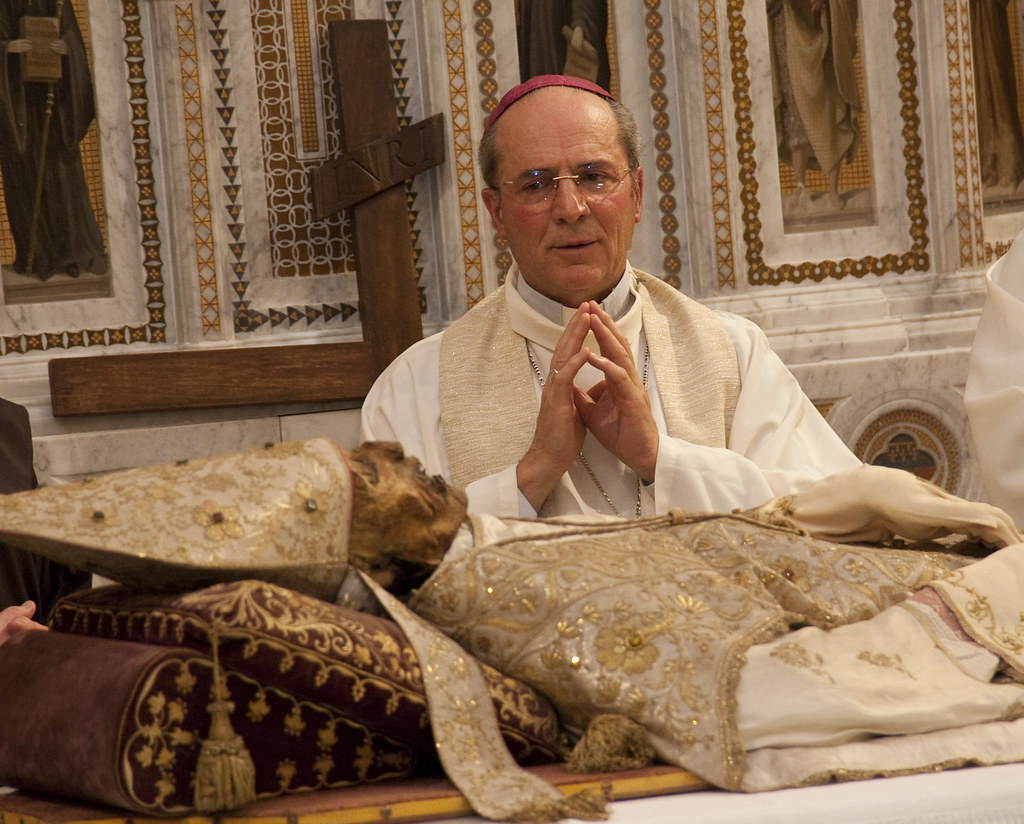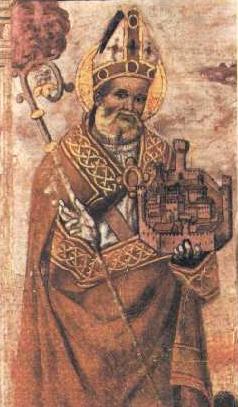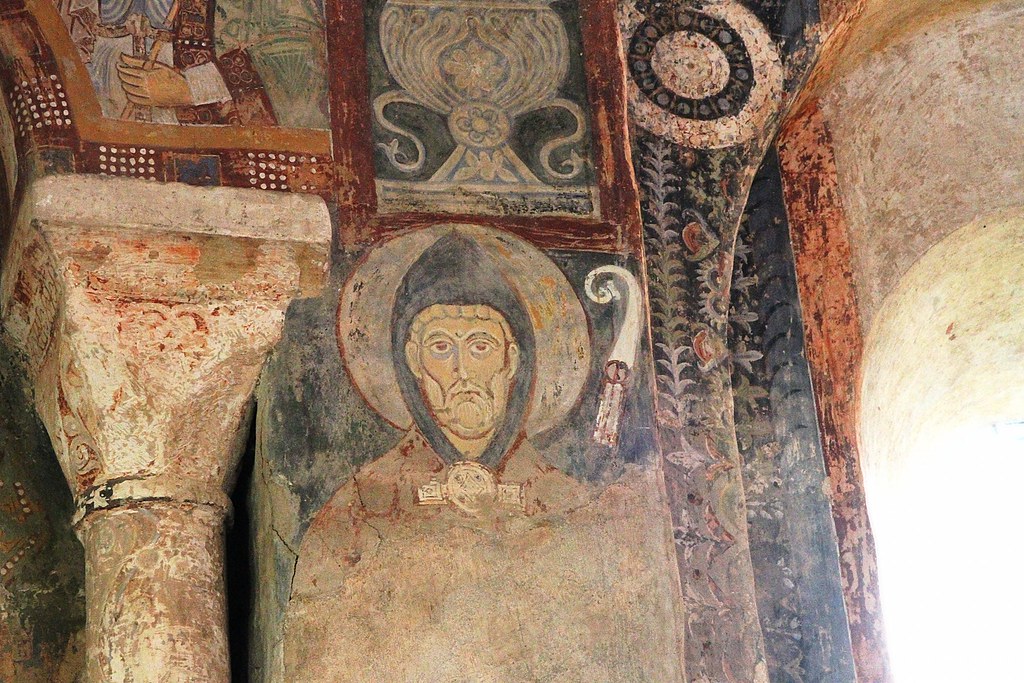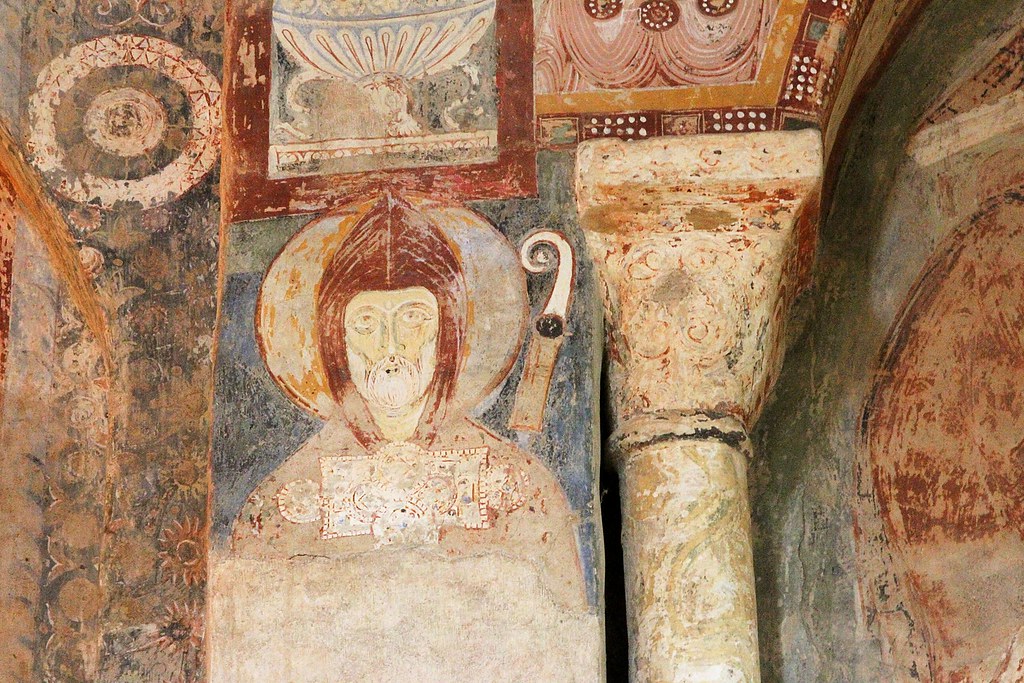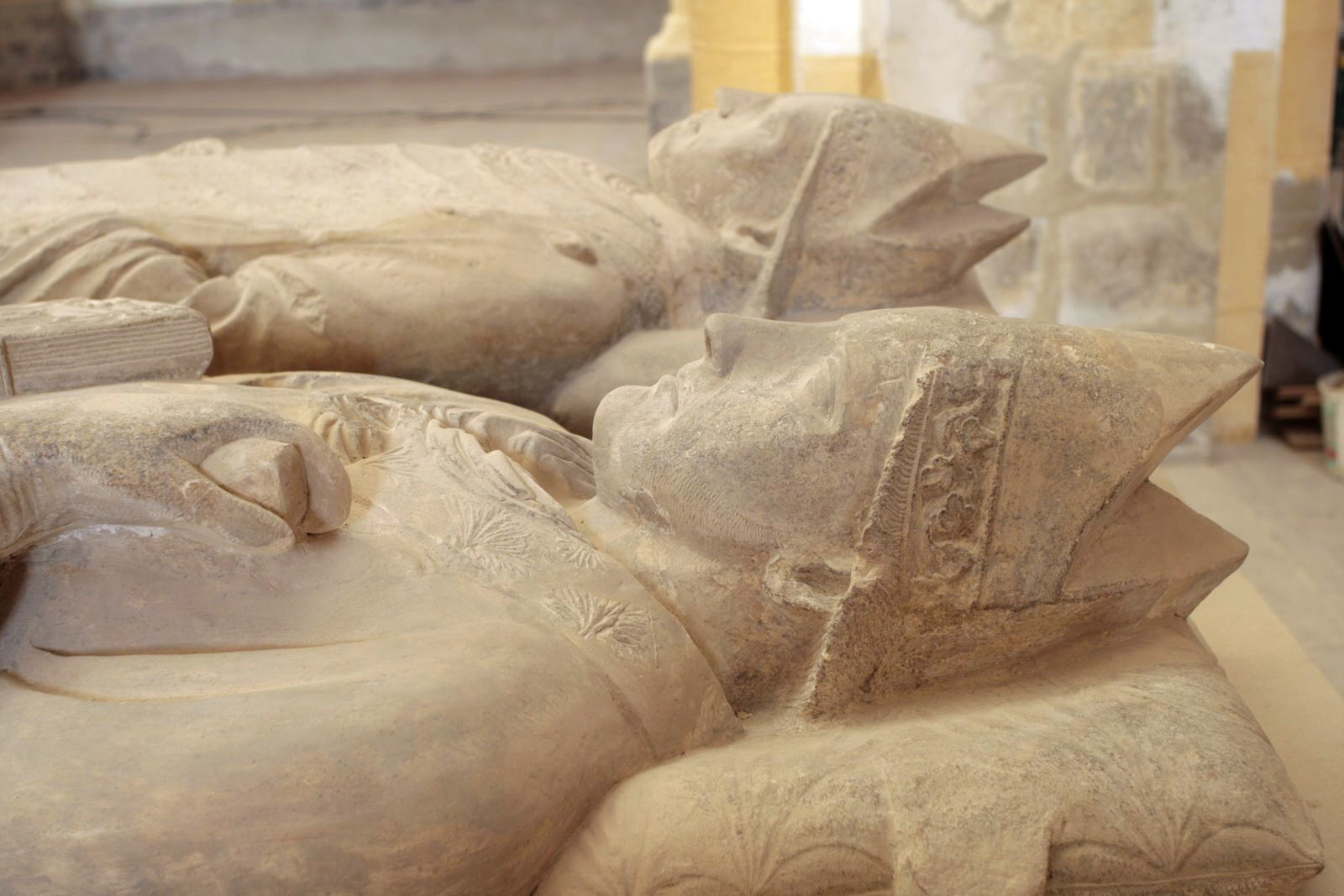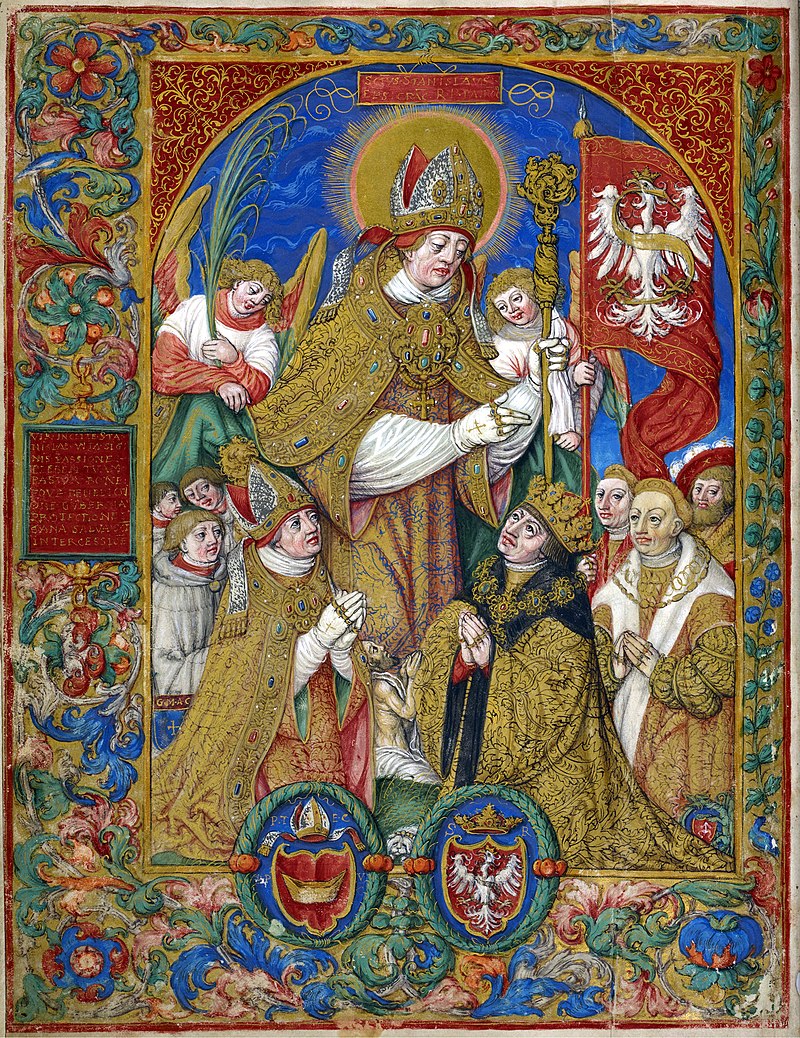In the light of the Pope's recent comments about establishing a commission to look into the historic evidence for the place of Deaconesses in ecclesial life today's post from Zenit includes an interesting article by Fr Edward Macnamara about the history of Deaconesses as a recognised ministry in the Catholic Church.
As this is likely to be alively topic amongst some of my friends I am reproducing the text in its entirity - complete with its illustration: now who only a few years ago would have depicted a Deacon with a maniple? How things have changed. :

Answered
by Legionary of Christ Father Edward McNamara, professor of liturgy and
dean of theology at the Regina Apostolorum university.
Q: Could you
please explain why historically the Church accepted women deacons and
yet since the second century this has been stopped? The Church of
England allowed women priests, and the number of its clergy almost
doubled in five years. Considering that Benedict XVI allowed married men
into the Catholic priesthood to open the Anglican door, could this not
be considered a key for Western rules on celibacy to be relaxed in the
future? — T.B., Salford, United Kingdom
A: There are
several questions in one. The decisions of the Church of England
regarding this question have no bearing on the Catholic Church. Pope
John Paul II effectively closed this debate with a declaration that the
Church does not have the power to ordain women priests.
Pope
Benedict XVI’s decision to allow married Anglican clergy to be ordained
to the Catholic priesthood (which John Paul II had already allowed in a
more-restricted manner) does not indicate a relaxation of the celibacy
rule, as the norms in place foresee that newly ordained clergy of the
Anglican-use ordinariates will be celibate.
Perhaps the
principal question regards deaconesses in the Church. Pope Francis
agreed to a proposal to set up a commission to study this question. This
question had already been touched upon in 2002 by a document of the
International Theological Commission: “From the Diakonia of Christ to
the Diakonia of the Apostles.” The whole document is
available on the Vatican website and is worthwhile reading so as to
have the full context of the part regarding deaconesses which we report
below.
“In the
apostolic era different forms of diaconal assistance offered to the
Apostles and communities by women seem to have been institutional. Thus
Paul recommends to the community at Rome ‘our sister Phoebe, servant [he diakonos] of the Church at Cenchreae’ (cf. Romans 16:1-4). Although the masculine form of diakonos is
used here, it cannot therefore be concluded that the word is being used
to designate the specific function of a ‘deacon’; firstly because in
this context diakonos
still signifies servant in a very general sense, and secondly
because the word ‘servant’ is not given a feminine suffix but preceded
by a feminine article. What seems clear is that Phoebe exercised a
recognized service in the community of Cenchreae, subordinate to the
ministry of the Apostle. Elsewhere in Paul’s writings the authorities of
the world are themselves called diakonos (Romans 13:4), and in Second Corinthians 11:14-15 he refers to diakonoi of the devil.
“Exegetes
are divided on the subject of First Timothy 3:11. The mention of ‘women’
following the reference to deacons may suggest women deacons (by
parallel reference), or the deacons’ wives who had been mentioned
earlier. In this epistle, the functions of the deacon are not described,
but only the conditions for admitting them. It is said that women must
not teach or rule over men (1 Timothy 2:8-15). But the functions of
governance and teaching were in any case reserved to the bishop (1
Timothy 3:5) and to priests (1 Timothy 5:17), and not to deacons. Widows
constituted a recognized group in the community, from whom they
received assistance in exchange for their commitment to continence and
prayer. First Timothy 5:3-16 stresses the conditions under which they
may be inscribed on the list of widows
receiving relief from the community, and says nothing more about any
functions they might have. Later on they were officially ‘instituted’
but ‘not ordained’; they constituted an ‘order’ in the Church, and would
never have any other mission apart from good example and prayer.
“At the
beginning of the second century a letter from Pliny the Younger,
governor of Bithynia, mentioned two women who were described by the
Christians as ministrae, the probable equivalent of the Greek diakonoi (10, 96-97). It was not until the third century that the specific Christian terms diaconissa or diaconal appeared.
“From the
end of the third century onwards, in certain regions of the Church (and
not all of them), a specific ecclesial ministry is attested to on the
part of women called deaconesses. This was in Eastern Syria and
Constantinople. Towards 240 there appeared a singular
canonico-liturgical compilation, the Didascalia Apostolorum (DA), which was not official in character. It attributed to the bishop the features of an omnipotent biblical patriarch (cf. DA
2, 33-35, 3). He was at the head of a little community which he
governed mainly with the help of deacons and deaconesses. This was the
first time that deaconesses appeared in an ecclesiastical document. In a
typology borrowed from Ignatius of Antioch, the bishop held the place
of God the Father, the deacon the place of Christ, and the deaconess
that of the Holy Spirit (the word for ‘Spirit’ is feminine in Semitic
languages), while the priests (who are seldom mentioned) represented the
Apostles, and the widows, the altar (DA 2, 26, 4-7). There is no reference to the ordination of these ministers.
“The Didascalia laid
stress on the charitable role of the deacon and the deaconess. The
ministry of the diaconate should appear as ‘one single soul in two
bodies.’ Its model is the diakonia of Christ, who washed the feet of his
disciples (DA 3, 13, 1-7). However, there was no strict
parallelism between the two branches of the diaconate with regard to the
functions they exercised. The deacons were chosen by the bishop to
‘concern themselves about many necessary things,’ and the deaconesses
only ‘for the service of women’ (DA 3, 12, 1). The hope was
expressed that ‘the number of deacons may be proportionate to that of
the assembly of the people of the Church’ (DA
3, 13, l). The deacons administered the property of the community in
the bishop’s name. Like the bishop, they were maintained at its
expense. Deacons are called the ear and mouth of the bishop (DA 2,
44, 3-4). Men from among the faithful should go through the deacons to
have access to the bishop, as women should go through the deaconesses (DA 3,
12, 1-4). One deacon supervised the entries into the meeting place,
while another attended the bishop for the Eucharistic offering (DA 2, 57, 6).
“Deaconesses
should carry out the anointing of women in the rite of baptism,
instruct women neophytes, and visit the women faithful, especially the
sick, in their homes. They were forbidden to confer baptism themselves,
or to play a part in the Eucharistic offering (DA 3, 12, 1-4).
The deaconesses had supplanted the widows. The bishop may still
institute widows, but they should not either teach or administer baptism
(to women), but only pray (DA 3, 5, 1-3, 6, 2).
“The Constitutiones Apostolorum, which appeared in Syria towards 380, used and interpolated the Didascalia, the Didache and the Traditio Apostolica. The Constitutiones were
to have a lasting influence on the discipline governing ordinations in
the East, even though they were never considered to be an official
canonical collection. The compiler envisaged the imposition of hands
with the epiklesis of the Holy Spirit not only for bishops, priests and
deacons, but also for the deaconesses, sub-deacons and lectors (cf. CA 8, 16-23).The concept of kleros
was broadened to all those who exercised a liturgical ministry, who
were maintained by the Church, and who benefited from the privileges in
civil law allowed by the Empire to clerics, so that the deaconesses were
counted as belonging to the clergy while the widows were excluded.
Bishop and priests were paralleled with the high priest and the priests
respectively of the Old Covenant, while to the Levites corresponded all
the other ministries and states of life: ‘deacons, lectors, cantors,
door-keepers, deaconesses, widows, virgins and orphans’ (CA 2, 26, 3; CA 8,
1, 21). The deacon was placed ‘at the service of the bishop and the
priests’ and should not impinge on the functions of the latter. The
deacon could proclaim the Gospel and conduct the prayer of the assembly (CA 2, 57, 18), but only the bishop and the priests exhorted (CA
2, 57, 7). Deaconesses took up their functions through an epithesis cheirôn or imposition of hands that conferred the Holy Spirit, as did the lectors (CA
8, 20, 22). The bishop pronounced the following prayer: ‘Eternal
God, Father of our Lord Jesus Christ, creator of man and woman, who
filled Myriam, Deborah, Anne and Hulda with your spirit; who did not
deem it unworthy for your Son, the Only-Begotten, to be born of a woman;
who in the tent of witness and in the temple did institute women as
guardians of your sacred doors, look now upon your servant before you,
proposed for the diaconate: grant her the Holy Spirit and purify her of
all defilement of flesh and spirit so that she may acquit herself
worthily of the office which has been entrusted to her, for your glory
and to the praise of your Christ, through whom be glory and adoration to
you, in the Holy Spirit, world without end. Amen.’
“The deaconesses were named before the sub-deacon who, in his turn, received a cheirotonia like the deacon (CA 8, 21), while the virgins and widows could not be ‘ordained’ (8, 24-25). The Constitutiones insist
that the deaconesses should have no liturgical function (3, 9, 1-2),
but should devote themselves to their function in the community which
was ‘service to the women’ (CA 3, 16, 1) and as intermediaries
between women and the bishop. It is still stated that they represent the
Holy Spirit, but they ‘do nothing without the deacon’ (CA
2, 26, 6). They should stand at the women’s entrances in the
assemblies (2, 57, 10). Their functions are summed up as follows: ‘The
deaconess does not bless, and she does not fulfill any of the things
that priests and deacons do, but she looks after the doors and attends
the priests during the baptism of women, for the sake of decency’ (CA 8, 28, 6).
“This is echoed by the almost contemporary observation of Epiphanius of Salamis in his Panarion, in
around 375: ‘There is certainly in the Church the order of deaconesses,
but this does not exist to exercise the functions of a priest, nor are
they to have any undertaking committed to them, but for the decency of
the feminine sex at the time of baptism.’ A law of Theodosius of 21 June
390, revoked on 23 August of the same year, fixed the age for admission
to the ministry of deaconesses at 60. The Council of Chalcedon (can.
15) reduced the age to 40, forbidding them subsequent marriage.
“Even in the
fourth century the way of life of deaconesses was very similar to that
of nuns. At that time the woman in charge of a monastic community of
women was called a deaconess, as is testified by Gregory of Nyssa among
others. Ordained abbesses of the monasteries of women, the deaconesses
wore the
maforion, or veil of perfection. Until the sixth century they
still attended women in the baptismal pool and for the anointing.
Although they did not serve at the altar, they could distribute
communion to sick women. When the practice of anointing the whole body
at baptism was abandoned, deaconesses were simply consecrated virgins
who had taken the vow of chastity. They lived either in monasteries or
at home. The condition for admission was virginity or widowhood and
their activity consisted of charitable and health-related assistance to
women.
“At
Constantinople the best-known of the fourth-century deaconesses was
Olympias, the superior of a monastery of women, who was a protégée of
Saint John Chrysostom and had put her property at the service of the
Church. She was ‘ordained’ (cheirotonein) deaconess with three of
her companions by the patriarch. Canon 15 of the Council of Chalcedon
(451) seems to confirm the fact that deaconesses really were ‘ordained’
by the imposition of hands (cheirotonia). Their ministry was called leitourgia and after ordination they were not allowed to marry.
“In
eighth-century Byzantium, the bishop still imposed his hands on a
deaconess, and conferred on her the orarion or stole (both ends of which
were worn at the front, one over the other); he gave her the chalice,
which she placed on the altar without giving communion to anyone.
Deaconesses were ordained in the course of the Eucharistic liturgy, in
the sanctuary, like deacons. Despite the similarities between the rites
of ordination, deaconesses did not have access to the altar or to any
liturgical ministry. These ordinations were intended mainly for the
superiors of monasteries of women.
“It should be pointed out that in the West there is no trace of any deaconesses for the first five centuries. The Statuta Ecclesiae antiqua laid
down that the instruction of women catechumens and their preparation
for baptism was to be entrusted to the widows and women religious
‘chosen ad ministerium baptizandarum mulierum.‘ Certain councils of the fourth and fifth centuries reject every ministerium feminae and forbid any ordination of deaconesses. According to the Ambrosiaster
(composed at Rome at the end of the fourth century), the female
diaconate was an adjunct of Montanist (‘Cataphrygian’) heretics. In the
sixth century women admitted into the group of widows were sometimes
referred to as deaconesses. To prevent any confusion the Council of
Epaone forbade ‘the consecrations of widows who call themselves
deaconesses.’ The Second Council of Orleans (533) decided to exclude
from communion women who had ‘received the blessing for the diaconate
despite the canons forbidding this and who had remarried.’ Abbesses, or
the wives of deacons, were also called diaconissae, by analogy with presbyterissae or even episcopissae.
“The present
historical overview shows that a ministry of deaconesses did indeed
exist, and that this developed unevenly in the different parts of the
Church. It seems clear that this ministry was not perceived as simply
the feminine equivalent of the masculine diaconate. At the very least it
was an ecclesial function, exercised by women, sometimes mentioned
together with that of sub-deacon in the lists of Church ministries. Was
this ministry conferred by an imposition of hands comparable to that by
which the episcopate, the priesthood and the masculine diaconate were
conferred? The text of the Constitutiones Apostolorum
would seem to suggest this, but it is practically the only witness
to this, and its proper interpretation is the subject of much debate.
Should the imposition of hands on deaconesses be considered the same as
that on deacons, or is it rather on the same level as the imposition of
hands on sub-deacons and lectors? It is difficult to tackle the question
on the basis of historical data alone. In the following chapters some
elements will be clarified, and some questions will remain open. In
particular, one chapter will be devoted to examining more closely how
the Church through her theology and Magisterium has become more
conscious of the sacramental reality of Holy Orders and its three
grades. But first it is appropriate to examine the causes which led to
the disappearance of the permanent diaconate in the life of the Church.”
The document at a later stage describes the disappearance of deaconesses:
“After the
tenth century deaconesses were only named in connection with charitable
institutions. A Jacobite author of that time notes: ‘In ancient times,
deaconesses were ordained. Their function was to look after women so
that they should not have to uncover themselves before the bishop. But
when religion spread more widely and it was decided to administer
baptism to infants, this function was abolished.’ We find the same
statement in the Pontifical of Patriarch Michael of Antioch (1166-1199).
When commenting on can. 15 of the Council of Chalcedon, Theodore
Balsamon, at the end of the twelfth century, observed that ‘the topic of
this canon has altogether fallen into disuse. For today deaconesses are
no longer ordained, although the name of deaconesses is wrongly given
to those who belong to
communities of ascetics.’ Deaconesses had become nuns. They lived in
monasteries which no longer practiced works of diakonia except in the field of education, medical care, or parish service.
“The
presence of deaconesses is still attested in Rome at the end of the
eighth century. While the Roman rituals had previously not mentioned
deaconesses, the sacramentary Hadrianum, sent by the pope to Charlemagne and spread by him throughout the Frankish world, includes an Oratio ad diaconam faciendum. It
was in fact a blessing, placed as an appendix among other rites of
first institution. The Carolingian texts often combined deaconesses and
abbesses. The Council of Paris of 829 contained a general prohibition on
women performing any liturgical function. The Decretals of
Pseudo-Isidore contain no mention of deaconesses; and neither does a
Bavarian Pontifical from the first half of the ninth century. A century
later, in the Pontifical Romano-Germanique of Mainz, the prayer Ad diaconam faciendum
is to be found after the ordinatio abbatissae, between the consecratio virginum and the consecratio viduarum. Once
again, this was merely a blessing accompanied by the handing over of
the stole and veil by the bishop, as well as the nuptial ring and the
crown. Like widows, the deaconess promised continence. This is the last
mention of ‘deaconesses’ found in the Latin rituals. In fact the
Pontifical of Guillaume Durand at the end of the thirteenth century
speaks of deaconesses only with reference to the past.
“In the Middle Ages, the nursing and teaching religious orders of nuns fulfilled in practice the functions of diakonia without,
however, being ordained for this ministry. The title, with no
corresponding ministry, was given to women who were instituted as widows
or abbesses. Right up until the thirteenth century, abbesses were
sometimes called deaconesses.”
Finally,
having analyzed the theology of the various degrees of the sacrament of
orders, the document reached the following conclusion:
“With
regard to the ordination of women to the diaconate, it should be noted
that two important indications emerge from what has been said up to this
point:
“1.
The deaconesses mentioned in the tradition of the ancient Church — as
evidenced by the rite of institution and the functions they exercised —
were not purely and simply equivalent to the deacons;
“2.
The unity of the sacrament of Holy Orders, in the clear distinction
between the ministries of the bishop and the priests on the one hand and
the diaconal ministry on the other, is strongly underlined by ecclesial
tradition, especially in the teaching of the Magisterium.
“In
the light of these elements which have been set out in the present
historico-theological research document, it pertains to the ministry of
discernment which the Lord established in his Church to pronounce
authoritatively on this question.”
The
documents of the International Theological Commission are authoritative
but are not magisterium as such. Any future commission will certainly
have to take its research and conclusions into account.


